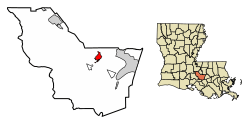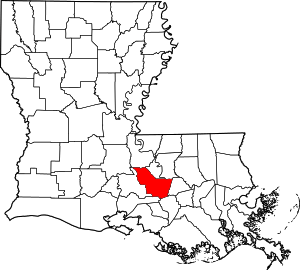Plaquemine, Louisiana
Plaquemine is a city in and the parish seat of Iberville Parish, Louisiana, United States.[5] The population was 7,119 at the 2010 census.[6] It is part of the Baton Rouge Metropolitan Statistical Area.
Plaquemine, Louisiana | |
|---|---|
City | |
 Old Square | |
| Nickname(s): "City of Hospitality"[1] | |
 Location of Plaquemine in Iberville Parish, Louisiana | |
.svg.png) Location of Louisiana in the United States | |
| Coordinates: 30°17′03″N 91°14′26″W | |
| Country | United States |
| State | Louisiana |
| Parish | Iberville |
| Settled | 1775 |
| Incorporated | 1838 |
| Government | |
| • Mayor | Edwin M. "Ed" Reeves Jr. (D)[2] |
| Area | |
| • Total | 3.01 sq mi (7.78 km2) |
| • Land | 2.92 sq mi (7.57 km2) |
| • Water | 0.08 sq mi (0.21 km2) |
| Elevation | 23 ft (7 m) |
| Population (2010) | |
| • Total | 7,119 |
| • Estimate (2019)[4] | 6,539 |
| • Density | 2,237.09/sq mi (863.74/km2) |
| Time zone | UTC-6 (CST) |
| • Summer (DST) | UTC-5 (CDT) |
| ZIP code | 70764 |
| Area code(s) | 225 |
| FIPS code | 22-60880 |
| Website | www |
History
Early inhabitants of the area were the Chitimacha people. Pierre Le Moyne d'Iberville claimed all of Louisiana in 1699 for King Louis XIV of France.[1] Plaquemine was settled by 1775 and named for the Native word Plakemine, which means persimmon.[7]
Due to its location at the juncture of the Bayou Plaquemine and the Mississippi River, the village soon began to prosper and grow, beginning a long history of prosperity. By 1838, the town was incorporated,[8] electing Zenon LaBauve, for whom a street in New Orleans' Garden District is named, as its first mayor.[9]

Plaquemine continued to grow in the Antebellum era. Massive plantations were established in nearby regions, including St. Louis, Nottoway, and Belle Grove. The town has been the seat of Iberville Parish government since its incorporation. The second parish courthouse (c. 1906) on Railroad Avenue has been serving as City Hall since 1985. Plaquemine did not have a hospital until 1923.[10]
Plaquemine has been a Louisiana-designated Main Street City since 1993.[11] There are ten properties listed for Plaquemine on the National Register of Historic Places in Iberville Parish, Louisiana.
Geography
Plaquemine is located at 30°17′3″N 91°14′26″W (30.284044, −91.240485)[12] and has an elevation of 23 feet (7.0 m).[13] Plaquemine is located at the junction of Bayou Plaquemine and the Mississippi River. The city itself is surrounded by farmland; beyond the farmland to the west lies nearly uninhabited swampland.
According to the United States Census Bureau, the city has a total area of 3.0 square miles (7.8 km2), of which 2.9 square miles (7.6 km2) are land and 0.1 square miles (0.2 km2), or 2.75%, are water.[6]
Demographics
| Historical population | |||
|---|---|---|---|
| Census | Pop. | %± | |
| 1860 | 1,663 | — | |
| 1870 | 1,460 | −12.2% | |
| 1880 | 2,061 | 41.2% | |
| 1890 | 3,222 | 56.3% | |
| 1900 | 3,590 | 11.4% | |
| 1910 | 4,955 | 38.0% | |
| 1920 | 4,632 | −6.5% | |
| 1930 | 5,124 | 10.6% | |
| 1940 | 5,049 | −1.5% | |
| 1950 | 5,747 | 13.8% | |
| 1960 | 7,689 | 33.8% | |
| 1970 | 7,739 | 0.7% | |
| 1980 | 7,521 | −2.8% | |
| 1990 | 7,186 | −4.5% | |
| 2000 | 7,064 | −1.7% | |
| 2010 | 7,119 | 0.8% | |
| Est. 2019 | 6,539 | [4] | −8.1% |
| U.S. Decennial Census[14] | |||
As of the census[15] of 2000, there were 7,064 people, 2,593 households, and 1,846 families residing in the city. The population density was 2,467.0 people per square mile (953.6/km2). There were 2,828 housing units at an average density of 987.6 per square mile (381.8/km2). The racial makeup of the city was 49.26% White, 49.60% African American, 0.17% Native American, 0.27% Asian, 0.03% Pacific Islander, 0.08% from other races, and 0.58% from two or more races. Hispanic or Latino of any race were 1.15% of the population.
There were 2,593 households out of which 29.7% had children under the age of 18 living with them, 44.0% were married couples living together, 22.7% had a female householder with no husband present, and 28.8% were non-families. 26.5% of all households were made up of individuals and 10.5% had someone living alone who was 65 years of age or older. The average household size was 2.64 and the average family size was 3.21.
In the city, the population was spread out with 25.8% under the age of 18, 8.9% from 18 to 24, 25.9% from 25 to 44, 22.8% from 45 to 64, and 16.5% who were 65 years of age or older. The median age was 37 years, higher than Louisiana's median age of 34.0 years. For every 100 females, there were 88.2 males. For every 100 females age 18 and over, there were 82.3 males.
The median income for a household in the city was $28,364, and the median income for a family was $32,971. Males had a median income of $34,868 versus $21,016 for females. The per capita income for the city was $14,066. About 23.6% of families and 24.4% of the population were below the poverty line, including 35.8% of those under age 18 and 17.5% of those age 65 or over.
Historic economy
The lumber industry boomed in the mid-18th century and did not slacken until available supplies of massive virgin bald cypress trees were exhausted circa 1930. Plaquemine produced over 1.5 million board feet (3500 m³) per year in her sawmills.
The Plaquemine Lock, constructed from 1895–1909, was an important link between the Mississippi River and the Intracoastal Canal, of which Bayou Plaquemine served as its northern terminus.[16] Its design served as the prototype for the Panama Canal locks. The Plaquemine Lock was shut down in 1961. In 1974, the Army Corps of Engineers supervised the construction of the levee that runs across the mouth of Bayou Plaquemine at the Mississippi River. The Plaquemine Lock was placed on the National Register of Historic Places in 1972. The area now operates as a state park.[17][18]
Culture
Annual cultural events
Plaquemine's annual International Acadian Festival draws visitors from all over the world.[19] Local Mardi Gras celebrations also attract tourists.[20]
Tourism
Plaquemine is noted for a number of antebellum structures that survive within the city limits and along Bayou Road. One of the most noteworthy homes is St. Basil's, a riverfront mansion built by socialite physician Dr. John Scratchley in the 1850s. Now a private residence, the home retains the name St. Basil's from when it was a fashionable convent school. [21]
The Iberville Museum was built in 1949 as the Iberville Parish Courthouse. The building served as Plaquemine's first city hall, and was the city seat of government until 1985. It now serves as a parish museum, and the building is on the National Register of Historic Places.[22][23]
Infrastructure
Transportation
Plaquemine is accessed by four highways: LA 3066, LA 75, LA 77, and the scenic LA 1. Other highways include LA 992 (Tenant Road) and LA 405. LA 3066 continues from Court Street to "Down the Bayou" neighborhoods. LA 75 accesses east over the Mississippi River via toll ferry to Saint Gabriel and leads southwest from Plaquemine, eventually reaching Bayou Pigeon. LA 77 starts around the Island Country Club and continues northwest to Maringouin. LA 1 runs north to Interstate 10/Baton Rouge and south to Donaldsonville. Plaquemine lacks public transportation and its residents rely completely on the use of the automobile.
Education
Iberville Parish School Board operates public schools.
Plaquemine High School is outside the city limits, in an unincorporated area.[24]
Mathematics, Science, and Arts Academy - West is outside the city limits, in an unincorporated area.[25]
Notable people
- Chad M. Brown, member of the Louisiana House of Representatives for Iberville and Assumption parishes, effective January 2016
- Robert "Bobby" Freeman (1934-2016), lieutenant governor of Louisiana from 1980 to 1988; Plaquemine lawyer
- Davon Godchaux, American football player
- Bill Lee, former Major League Baseball pitcher, played for the Chicago Cubs, Philadelphia Phillies, and Boston Braves[26]
- Brian Mitchell, former Washington Redskins football player, played football at Plaquemine High School[27]
- Karen St. Germain, member of the Louisiana House of Representatives for Iberville and Assumption parishes, 2004–2016; resides in Plaquemine
- Clarence Williams, early jazz pianist and composer[28]
National Guard
Plaquemine is the home of the 256th Brigade Special Troops Battalion, formerly known as the 1088th Engineer Battalion,[29] a unit made up of combat engineer, military intelligence, signal, military police and other supporting units. The 256th BSTB is part of the 256th Infantry Brigade of the Louisiana Army National Guard that served in Iraq from 2004–2005.
References
- "Things to Do". City of Plaquemine. Archived from the original on December 2, 2013. Retrieved December 2, 2013.
- "City of Plaquemine Mayor". City of Plaquemine. Retrieved July 11, 2018.
- "2019 U.S. Gazetteer Files". United States Census Bureau. Retrieved July 25, 2020.
- "Population and Housing Unit Estimates". United States Census Bureau. May 24, 2020. Retrieved May 27, 2020.
- "Find a County". National Association of Counties. Retrieved June 7, 2011.
- "Geographic Identifiers: 2010 Census Summary File 1 (G001): Plaquemine city, Louisiana". American Factfinder. U.S. Census Bureau. Archived from the original on February 13, 2020. Retrieved April 3, 2018.
- "A bayou runs through it - Plaquemine, LA". National Geographic. Retrieved December 2, 2013.
- "CITY OF PLAQUEMINE". Iberville Parish. Archived from the original on October 22, 2013. Retrieved December 2, 2013.
- "The Bicentennial of the Louisiana Supreme Court". Louisiana Supreme Court. Retrieved December 2, 2013.
- Fama, Anthony (2004). "Part Five: The Plaquemine Sanitarium". Plaquemine: A Long, Long Time Ago. p. 25.
- "A bayou runs through it - Plaquemine, LA". National Geographic. Retrieved December 2, 2013.
- "US Gazetteer files: 2010, 2000, and 1990". United States Census Bureau. February 12, 2011. Retrieved April 23, 2011.
- "US Board on Geographic Names". United States Geological Survey. October 25, 2007. Retrieved January 31, 2008.
- "Census of Population and Housing". Census.gov. Retrieved June 4, 2015.
- "U.S. Census website". United States Census Bureau. Retrieved January 31, 2008.
- "Plaquemine Lock State Historic Site". LOUISIANA DEPARTMENT OF CULTURE RECREATION AND TOURISM. Archived from the original on December 3, 2013. Retrieved December 2, 2013.
- "Plaquemine Lock State Historic Site". American Park Network. Retrieved December 2, 2013.
- "Plaquemine Lock State Historic Site". Word Press. Retrieved December 2, 2013.
- "International Acadian Festival". Knights of Columbus Council 970. Retrieved December 2, 2013.
- "Mardi Gras Annual Parade". City of Plaquemine. Retrieved December 2, 2013.
- "Plaquemine Lock State Historic Site". Louisiana State Parks. Archived from the original on December 3, 2013. Retrieved December 2, 2013.
- "Iberville Museum". The Museum Building. Archived from the original on July 7, 2010. Retrieved December 2, 2013.
- "Attractions". Iberville Parish. Retrieved December 2, 2013.
- "Home". Plaquemine High School. Retrieved September 9, 2019.
59595 Belleview Drive, Plaquemine, LA 70764
- "Home". Mathematics, Science, and Arts Academy - West. Retrieved September 9, 2019.
MSA-West Academy 57955 St Louis Rd, Plaquemine, LA 70764
- "Bill Lee World Series Stats". Baseball Almanac. Retrieved December 2, 2013.
- "Brian Mitchell". databaseFootball.com. Retrieved December 2, 2013.
- "Clarence Williams". RedHotJazz. Archived from the original on January 7, 2010. Retrieved December 2, 2013.
- "256TH GUARDSMEN CONTINUE TO ASSIST WITH FLOOD RESPONSE". Louisiana National Guard. Retrieved December 2, 2013.

